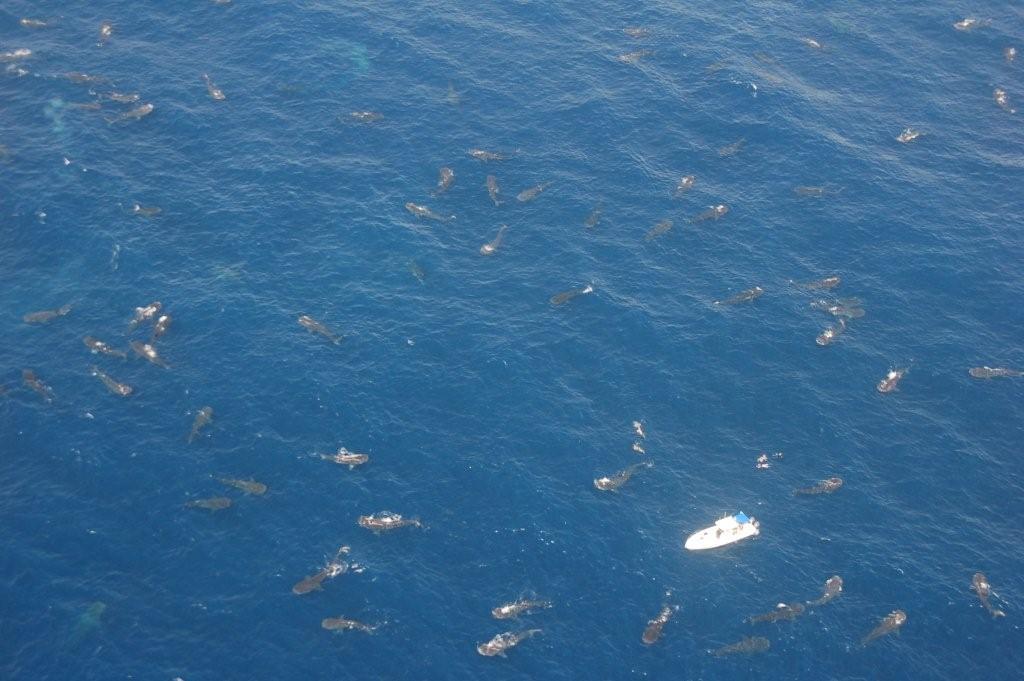Whale Sharks' Shared Feast Sets Record

The whale sharks spied in one group off the Yucatán Peninsula in Mexico two years ago numbered up to 420 — the largest gathering of the mysterious behemoths ever recorded, scientists said Wednesday (May 25).
The gathering, known as an "afuera" (Spanish for "outside"), occurred in August 2009, when the animals were observed crowded in an elliptical patch of ocean about 7 square miles (18 square kilometers).
The observation was reported by LiveScience in March, but this is the first time scientists have tallied the beasts and reported their extensive analysis of the sharks' food choices and whereabouts.
The whale sharks sailed in to feed on dense patches of fish eggs, the researchers reported online April 29 in the journal PLoS ONE.
"Whale sharks are the largest species of fish in the world, yet they mostly feed on the smallest organisms in the ocean, such as zooplankton," Mike Maslanka, a biologist at the Smithsonian Conservation Biology Institute, said in a statement. [Images of whale sharks]
The study opens a window into the life of one of the largest but least known fish in the ocean. Whale sharks (Rhincodon typus) grow longer than 40 feet (12 meters). They live most of their lives out of sight, leaving many questions about what they eat, how they breed, and where they go (and what they do) when they aren't feeding in shallow-water areas like the Mexican waters.
To get a better idea of what goes on during these feeding frenzies, which have been known to occur over the past few years, the team took dozens of trips to the area. The researchers collected food samples within and outside the school of feeding whale sharks. Using DNA analyses, they identified the fish eggs as those from little tunny (Euthynnus alletteratus), a member of the mackerel family.
Get the world’s most fascinating discoveries delivered straight to your inbox.
Scientists suspect the little tunny spawn at night and their eggs rise to the surface in the morning. "The sharks come in and literally swim at surface level with their mouths wide open, just vacuuming in the eggs," Jennifer Schmidt, a biologist at the University of Illinois at Chicago, told LiveScience in March.
Little tunny and plankton may not satiate the whale sharks. The researchers studied a less dense aggregation of whale sharks — this one known as the Cabo Catoche aggregation — off the northern tip of the Yucatán Peninsula. The whale sharks there were feeding on mostly small crustaceans called copepods and shrimp.
Larger afuera gatherings turned out to coincide with a drop in whale-shark sightings at Cabo Catoche. And both groups had the same sex ratio, suggesting these were the same animals traveling between the all-you-can-eat buffets.
"With two significant whale shark aggregation areas and, at the very least, one active spawning ground for little tunny, the northeastern Yucatán marine region is a critical habitat that deserves more concerted conservation effort," Maslanka said.
The whale shark is listed as "vulnerable" by the International Union for Conservation of Nature, and it is protected from capture around the world.
Follow LiveScience for the latest in science news and discoveries on Twitter @livescienceand on Facebook.
Jeanna Bryner is managing editor of Scientific American. Previously she was editor in chief of Live Science and, prior to that, an editor at Scholastic's Science World magazine. Bryner has an English degree from Salisbury University, a master's degree in biogeochemistry and environmental sciences from the University of Maryland and a graduate science journalism degree from New York University. She has worked as a biologist in Florida, where she monitored wetlands and did field surveys for endangered species, including the gorgeous Florida Scrub Jay. She also received an ocean sciences journalism fellowship from the Woods Hole Oceanographic Institution. She is a firm believer that science is for everyone and that just about everything can be viewed through the lens of science.


